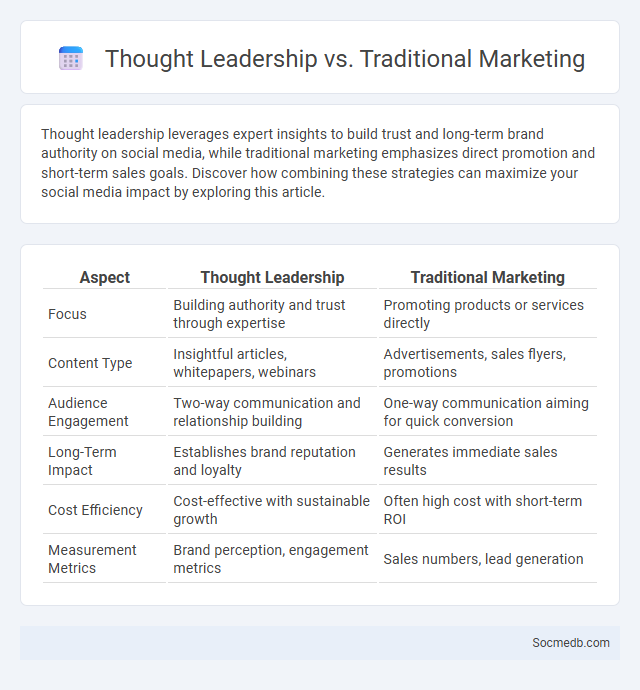
Photo illustration: Thought Leadership vs Traditional Marketing
Thought leadership leverages expert insights to build trust and long-term brand authority on social media, while traditional marketing emphasizes direct promotion and short-term sales goals. Discover how combining these strategies can maximize your social media impact by exploring this article.
Table of Comparison
| Aspect | Thought Leadership | Traditional Marketing |
|---|---|---|
| Focus | Building authority and trust through expertise | Promoting products or services directly |
| Content Type | Insightful articles, whitepapers, webinars | Advertisements, sales flyers, promotions |
| Audience Engagement | Two-way communication and relationship building | One-way communication aiming for quick conversion |
| Long-Term Impact | Establishes brand reputation and loyalty | Generates immediate sales results |
| Cost Efficiency | Cost-effective with sustainable growth | Often high cost with short-term ROI |
| Measurement Metrics | Brand perception, engagement metrics | Sales numbers, lead generation |
Understanding Thought Leadership
Thought leadership on social media establishes authority by consistently sharing innovative insights, expert knowledge, and forward-thinking ideas within a specific industry. Engaging content, such as in-depth articles, insightful videos, and meaningful conversations, fosters trust and credibility among targeted audiences. Metrics like follower growth, engagement rate, and shareability measure the impact and influence of thought leaders in digital communities.
Defining Traditional Marketing
Traditional marketing encompasses offline strategies such as print advertisements, television and radio commercials, direct mail, and billboard promotions aimed at broad consumer audiences. These methods rely heavily on one-way communication channels and often provide limited interaction and measurable feedback compared to social media platforms. Despite the rise of digital marketing, traditional marketing remains a foundational tool for brand awareness and local market penetration.
Key Differences: Thought Leadership vs Traditional Marketing
Thought leadership on social media emphasizes sharing expert insights, fostering trust, and building a loyal audience through valuable content, whereas traditional marketing focuses on direct promotion and broad messaging to drive immediate sales. Your social media strategy benefits from thought leadership by cultivating long-term relationships and enhancing brand credibility. Traditional marketing often relies on paid ads and repetitive calls-to-action, contrasting with the authentic engagement and educational approach characteristic of thought leadership.
Benefits of Thought Leadership
Thought leadership on social media enhances brand credibility by showcasing expertise and innovative insights within a specific industry. It drives meaningful engagement with targeted audiences, fostering trust and loyalty while expanding professional networks. Leveraging thought leadership builds competitive advantage and increases visibility, ultimately generating higher-quality leads and business opportunities.
Advantages of Traditional Marketing
Traditional marketing offers tangible materials such as brochures, flyers, and direct mail that create a lasting physical presence, enhancing brand credibility. It targets specific local audiences effectively through channels like TV, radio, and print newspapers, maximizing regional reach. High-impact outdoor advertising, including billboards and event sponsorships, boosts visibility and fosters personal connections.
Audience Engagement: Which Approach Wins?
Audience engagement on social media thrives through content tailored to your target demographics, leveraging interactive elements like polls, quizzes, and live videos that foster direct participation. Platforms such as Instagram and TikTok emphasize visually compelling stories, while LinkedIn is optimal for professional discussions and thought leadership, maximizing relevance. Understanding your audience's preferences and behaviors through analytics ensures your engagement strategy consistently evolves and wins attention.
Content Strategy: Thought Leadership vs Traditional Marketing
Content strategy on social media emphasizes thought leadership by creating insightful, authoritative content that builds trust and fosters long-term audience engagement. Traditional marketing relies on promotional messages and direct advertising to drive immediate sales and brand awareness. Leveraging thought leadership enhances brand credibility and drives sustainable growth through organic reach, whereas traditional marketing offers quick, measurable returns through paid campaigns.
Measuring Success: Metrics and KPIs
Measuring success on social media involves analyzing key performance indicators (KPIs) such as engagement rate, reach, impressions, click-through rate (CTR), and conversion rate. Metrics like follower growth, average session duration, and bounce rate provide insights into audience behavior and content effectiveness. Tracking these data points enables businesses to optimize strategies, improve brand awareness, and increase return on investment (ROI).
When to Use Thought Leadership vs Traditional Marketing
Thought leadership excels in building long-term trust and authority by sharing expert insights and innovative ideas, making it ideal for complex products or emerging industries. Traditional marketing is more effective for short-term campaigns aimed at boosting immediate sales or brand recognition through clear, direct messaging. Choosing between the two depends on your strategic goals, target audience maturity, and the desired impact on brand perception.
Integrating Both Strategies for Maximum Impact
Integrating organic and paid social media strategies maximizes audience reach and engagement by leveraging the strengths of both approaches. Organic content builds authentic relationships and brand loyalty through consistent, value-driven posts, while paid campaigns target specific demographics with precision to accelerate growth and conversions. Combining data insights from both strategies enhances content optimization and drives measurable ROI across multiple social platforms.
 socmedb.com
socmedb.com